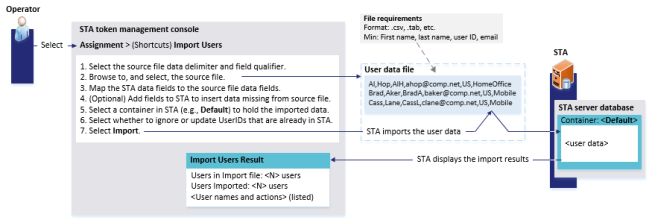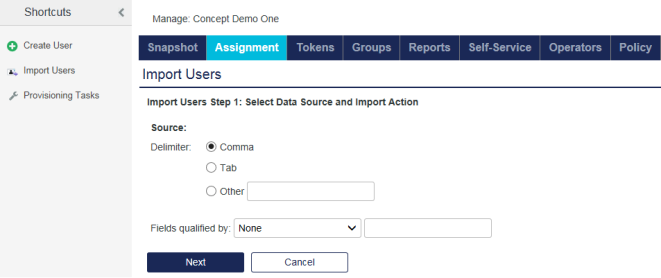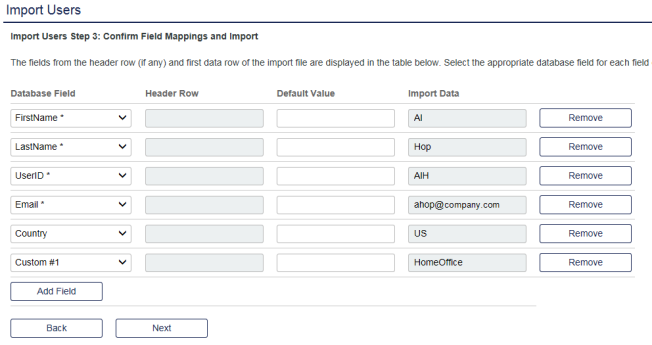Users and groups
You can add users to the account in the following ways:
Manually add one user at a time
Manually adding a user is a convenient way to accommodate small additions.

-
On the STA Token Management console, click Create User in Shortcuts.
The Create User options are displayed.

-
Enter the required information:
-
First Name
-
Last Name
-
User ID
-
Email
The Add button becomes active when you populate these fields.
-
-
Enter the remaining information, as required:
-
UserID: Must be unique. If an identical UserID already exists, an error message is displayed.
-
Email: Address is required. It is used in provisioning and self-enrollment.
-
Mobile/SMS: This field is required to provision the user with the SMS/OTP authentication method and should contain the SMS number of recipient’s mobile device. The number must always begin with the country code, bearing in mind that all characters other than digits are automatically stripped.
For example:
-
In North America, the entry +1-613-599-2441 after stripping out non-numeric characters would result in a message delivery to 16135992441, where 1 is the country code, 613 is the area code, and the remaining seven digits are the phone number.
-
In the UK, the entry 44 870 111 2222 would result in an entry in the format 4408701112222, where 44 is the country code, 870 is the city code, and the remaining digits are the phone number.
-
-
Container: Use this option to place the user in a container.
-
Phone: This is an optional field which may contain spaces, periods (.), dashes (-) and plus signs (+) in addition to digits.
-
Custom #1, Custom #2, and Custom #3: These are optional fields that can be used to store additional data related to the user. The Custom #1 field is displayed in the User list. Note that the “Custom #x” labels can be changed from the Branding module, Custom labels section.
-
Alias #1, #2: Aliases can be used to create additional pseudo-UserIDs for a user, allowing the user to log on using their UserID or aliases and any of the tokens assigned to the user. A common application of aliases would be for a person with two domain UserIDs and two roles. For example, Bob and bob-sysadmin, the former being a standard user account, the latter being an account with elevated privileges. In this example, either ID can use the same token.
-
-
Click Add.
The user details are displayed.
After you add users, you can configure settings for individual users, such as authentication methods, access restrictions, group membership, and RADIUS attributes.
Manually import user records
Manually importing user records enables you to add numerous users in a
single operation.

-
On the STA Token Management console, select Assignment > (Shortcuts) Import Users.

-
Select the import file format and field qualifiers to match the import file qualifiers.
-
Select Next.
-
Browse to and select the user data import file.

-
Clear the File has a header row option if the import file does not include a header row.
-
Select Next.
-
In the Confirm Field Mappings and Import pane, select the appropriate Database field for each Import Data field.

There are four required Database fields:
-
FirstName
-
LastName
-
UserID (must be unique)
-
Email
Optionally, use Add Field and select the appropriate unused field name (for example, country code) from the drop-down list to add further rows and force data not contained in the import file into the database. Default values can be created for any added fields.
Data entered into any of the Default Value fields will be used to populate user records that do not have data in the corresponding import file field.
-
-
Select the container into which users should be imported.

The Do not import if the UserID exists in the database prevents a user record from being imported if it already exists in the database.
The Update user record if the UserID exists in the database will overwrite fields in the database with data from corresponding fields in the import file if a matching UserID is found in the database. Note that populated fields in the database will not be overwritten if a corresponding field is not included in the import file.
-
Click Import to complete the process.
When the import operation is finished the server displays a list of the users that were imported and any errors that occurred.
After you add users, you can configure settings for individual users, such as authentication methods, access restrictions, group membership, and RADIUS attributes.
Synchronize users from a directory server
Instead of manually adding users in STA, you can provision users from your user directory server.
After you add users, you can do the following:

